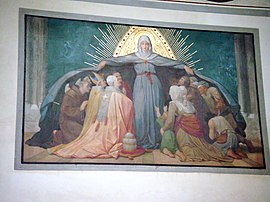Ferdinand Becker (painter)
Joseph Ferdinand Becker (born July 2, 1846 in Gonsenheim , † August 21, 1877 in Munich ), also known as the "painter Becker", was a painter of portraits of saints and fairytale scenes in the 19th century .
Life
Ferdinand Becker's father ran the inn "Zum golden Stern" in the Rheinhessen village of Gonsenheim near Mainz . One day when four-year-old Ferdinand was drawing a hunting scene on the wall of the inn with chalk, a guest who was an art connoisseur was very impressed by the boy's painting.
After finishing elementary school in 1860, Ferdinand wanted to train in painting, but his father prevented him from doing so, as he firmly believed: "My son cannot make a living from painting." Young Ferdinand found a job with wagons that consisted of loading wagons with stones and following them on foot in order to unload the stones again at their destination. But at night he secretly painted in his room.
The painter August Gustav Lasinsky , who worked on churches in Mainz in the 1860s, finally recognized Ferdinand Becker's artistic talent and trained him. From 1865 to 1868 Lasinsky restored the St. Ignaz parish church in Mainz together with his student Becker . Impressed by Becker's artistry, Lasinsky referred the young painter to further training with Professor Eduard Jakob von Steinle at the Städelsche Kunstinstitut in Frankfurt am Main . Ferdinand Becker stayed at this institute from November 19, 1868 to April 30, 1877, and it was during this period that most of his works were created.
Together with Steinle and Leopold Bode he painted a. a. the princely house chapel at Löwenstein Castle in Kleinheubach , with the pictures on the side walls and the medallions of saints by Becker, the main paintings on the altar wall by his teacher. On the painting there of a protective cloak Madonna are on the left under the cloak Pope Pius IX. and next to it the Mainz bishop Wilhelm Emmanuel von Ketteler is shown.
His best-known painting is Die Rolandsknappen , a watercolor cycle of 5 pictures in one frame; The Rolandsknappen became famous through exhibitions in Frankfurt , Berlin and Gonsenheim and was very popular everywhere. Together with the city of Mainz, the Mainz Art Association acquired this picture for 4,000 marks . Today it is in the holdings of the Mainz State Museum as a testimony to Nazarene art .
Known in art circles through the success of his Roland's miners , Ferdinand Becker received an order for two larger works from an art dealer in Munich . At the end of April 1877 the painter Becker traveled to Munich, where he undertook his studies in nature for this commission in the following months. At the beginning of August 1877 he became seriously ill and was admitted to a Munich hospital; there his health initially improved, but then deteriorated drastically within a short time. Ferdinand Becker died on August 21, 1877 in Munich of typhus fever . His body was transferred to his place of birth and buried in the old Gonsenheim cemetery, now the pastor-Grimm complex. His grave monument was later moved to the Gonsenheim forest cemetery.
In Mainz-Gonsenheim a street and a school are named after Ferdinand Becker, the Maler-Becker-Strasse and the Maler-Becker-Schule .
Works
- St. Pankratius in the dungeon , oil painting
- Rübezahl, Marktweiber frightening (1869–1870), oil painting
- The Holy Virgin with the Baby Jesus (1870), oil painting
- Saint Vitus (1870), oil painting
- Half-length portraits of saints (1870–1871), wall paintings in the chapel of Prince Löwenstein in Klein-Heubach am Main
- Friedrich with the bitten cheek (late 1871 - early 1872)
- The altarpiece in the Church of St. Peter in Mainz (1872),
- Further portraits of saints in Schloss Löwenstein Kleinheubach (1873), wall painting
- Frauenlob in Mainz (1873), oil painting
- Little brother and sister (1873–1874) based on the fairy tale of the Brothers Grimm
- The Jew in the Thorn (1874–1875) based on the fairy tale by the Brothers Grimm
- The Rolandsknappen (1876) based on the fairy tale Roland's Knappen by Johann Karl August Musäus
literature
D. Grimm: biography of the painter Jos. Ferdinand Becker von Gonsenheim . Mainz: Giani, 1878
Web links
- Biographies of Gonsenheim artists: painter Becker (1846 - 1877)
- Becker, Josef Ferdinand. Hessian biography. (As of November 28, 2019). In: Landesgeschichtliches Informationssystem Hessen (LAGIS).
- Entry on Ferdinand Becker in the Rhineland-Palatinate personal database
Individual evidence
- ^ Karl Esselborn, Georg Lehnert: Hessische Biographien , Volume 1, p. 134, new edition 1973, ISBN 3500268102 ; (Detail scan)
- ^ The Nazarenes - from the Tiber to the Rhine ( Memento from February 26, 2014 in the Internet Archive ) Three painting schools of the 19th century
gallery
| personal data | |
|---|---|
| SURNAME | Becker, Ferdinand |
| ALTERNATIVE NAMES | Becker, Joseph Ferdinand (full name) |
| BRIEF DESCRIPTION | German painter of portraits of saints and fairytale scenes |
| DATE OF BIRTH | July 2, 1846 |
| PLACE OF BIRTH | Gonsenheim |
| DATE OF DEATH | August 21, 1877 |
| Place of death | Munich |






